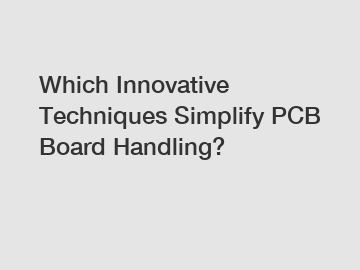Which Innovative Techniques Simplify PCB Board Handling?
In the fast-paced world of electronics manufacturing, Printed Circuit Boards (PCBs) are the backbone of technological innovation. As the demands for higher performance and miniaturization continue to rise, so does the need for efficient and foolproof handling techniques for these delicate and intricate components. In this blog, we will explore some of the most innovative techniques that are revolutionizing PCB board handling, making it simpler, smarter, and more reliable than ever before.
1. Automated Robotic Systems:
Embracing automation has been instrumental in streamlining various manufacturing processes, and PCB board handling is no exception. Automated robotic systems employ high-precision robots to swiftly and accurately manipulate PCBs during production. These robots possess advanced vision systems that ensure their movements are in perfect coordination with the boards, mitigating errors, and improving efficiency. With minimal human intervention, these systems not only reduce the handling time but also eliminate the risk of human error, ensuring consistent quality.

2. Vacuum-Based Manipulation:
Traditional methods of PCB handling often involve direct contact, which can leave smudges, fingerprints, or even cause surface scratches. Vacuum-based manipulation, on the other hand, has emerged as a reliable and non-contact approach to handle delicate PCBs. This technique employs specially designed suction cups or pads, connected to a vacuum system, to lift and maneuver boards without touching them directly. Vacuum handling not only minimizes the risk of contamination but also ensures gentle and secure gripping, reducing any chances of accidental damage during the handling process.
3. ESD-Safe Handling:
Electrostatic discharge (ESD) poses a significant risk to PCBs, as even a small static spark can irreversibly damage sensitive electronic components. To combat this, innovative techniques have been developed to ensure ESD-safe handling. Introducing conductive or dissipative materials in tools and equipment removes the threat of static charges building up during handling operations. ESD-safe workstations, grounding wrist straps, and antistatic bags play a vital role in preventing ESD-related mishaps. By implementing these measures, manufacturers can safeguard their PCBs from potential damage, enhancing reliability and product longevity.
4. Intelligent Material Handling Systems:
The advent of Artificial Intelligence (AI) has opened new avenues for optimizing and simplifying PCB board handling. Intelligent Material Handling Systems leverage AI algorithms and computer vision technology to intelligently identify, sort, and transport PCBs during production. Equipped with high-resolution cameras and advanced image recognition techniques, these systems quickly detect and classify boards, ensuring accurate placement and improved workflow. By eliminating manual sorting and reducing human involvement, these systems significantly enhance efficiency, speeding up production cycles while maintaining high levels of quality control.
5. Modular and Flexible Workflows:
Innovation is not just about introducing cutting-edge technology; it is also about reimagining workflows and processes. Modular and flexible workflows allow for quicker adaptability to changing production needs, ensuring optimal efficiency in PCB handling. By breaking down complex assembly tasks into smaller, standardized modules, manufacturers can easily swap, upgrade, or replace equipment, reducing downtime and enhancing productivity. These modular approaches also allow for easier troubleshooting and maintenance, as well as facilitating the integration of new handling techniques as they emerge.
Conclusion:
The world of PCB board handling is constantly evolving, driven by the pressing need for greater efficiency, reliability, and throughput. By harnessing the power of automation, non-contact handling, ESD-safe practices, AI algorithms, and flexible workflows, manufacturers are achieving groundbreaking advancements in simplifying the handling of PCBs. These state-of-the-art techniques not only maximize productivity but also ensure consistent quality, enabling the electronics industry to continuously push the boundaries of innovation. Embracing these innovative approaches is the key to unlocking a future where PCB board handling becomes ever more effortless and efficient.
Are you interested in learning more about PCB Labeling, Customization Smt, SMT PCB Stacker Unloader? Contact us today to secure an expert consultation!


